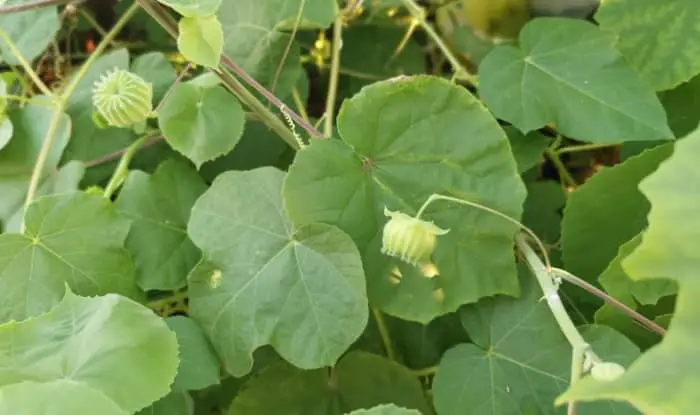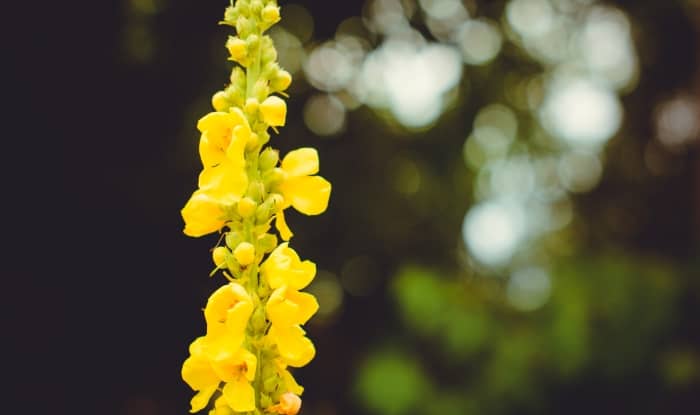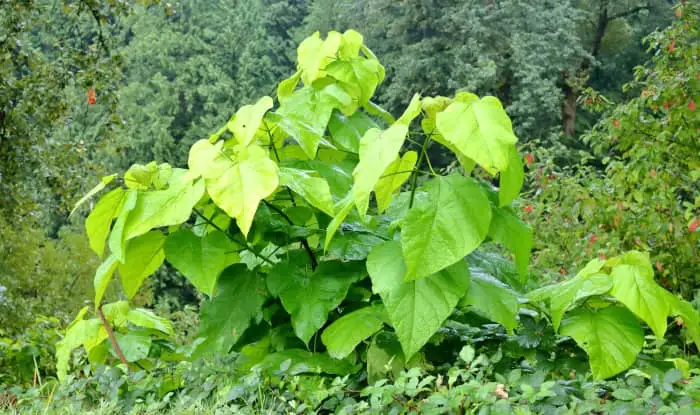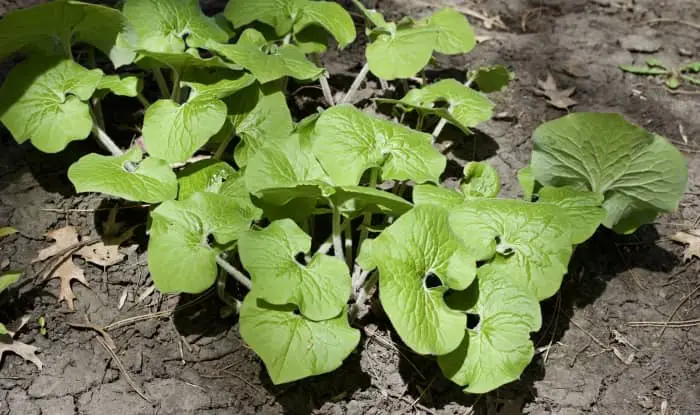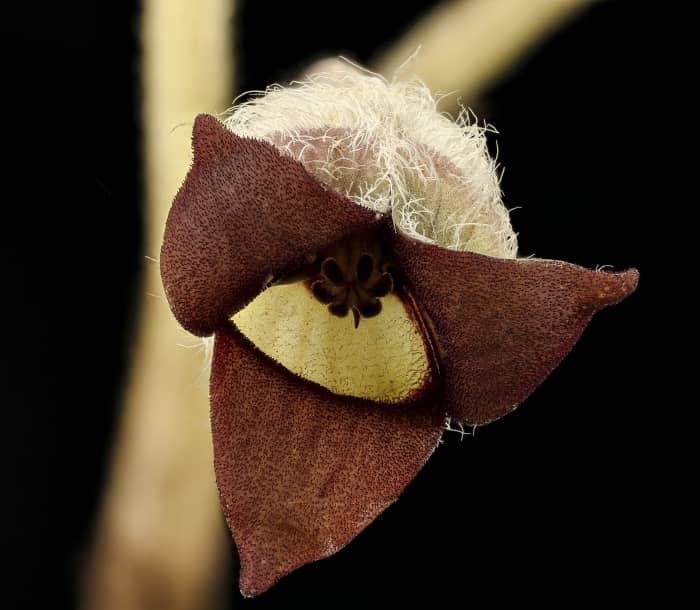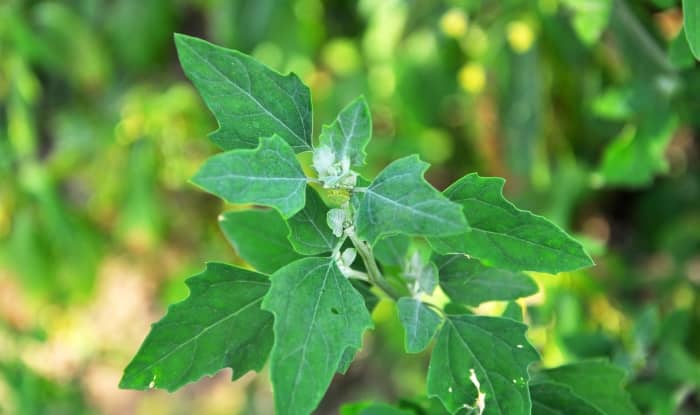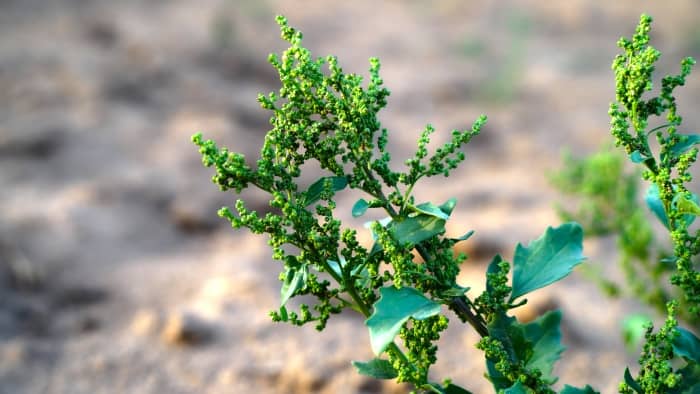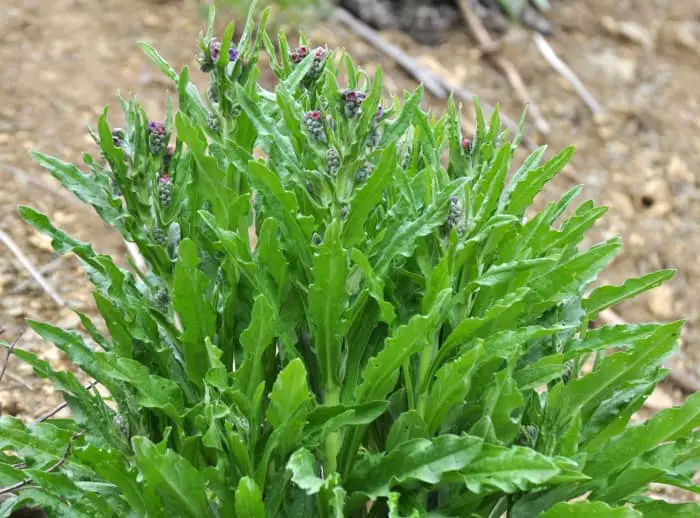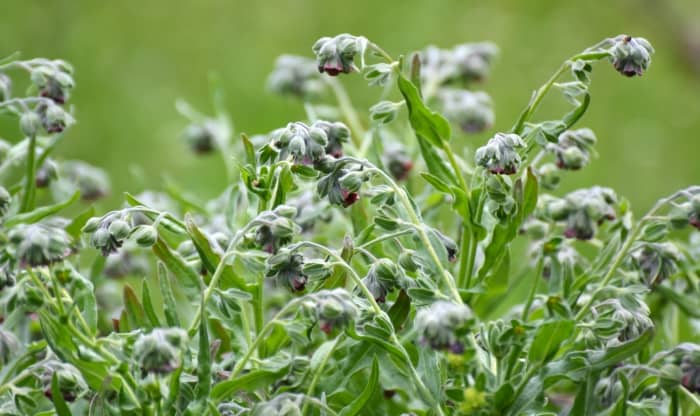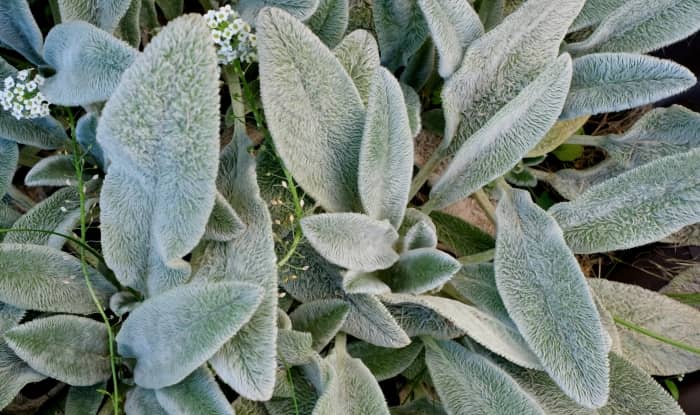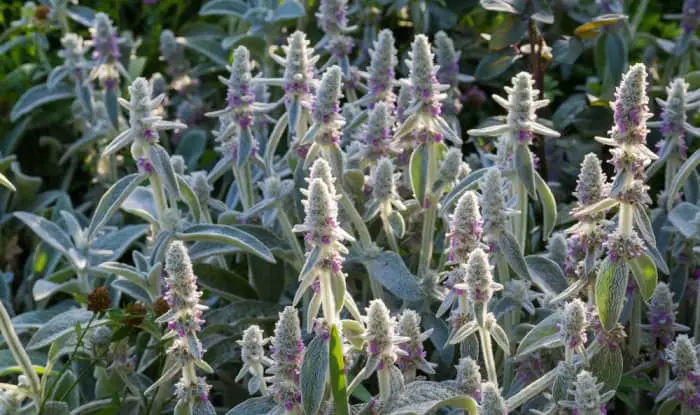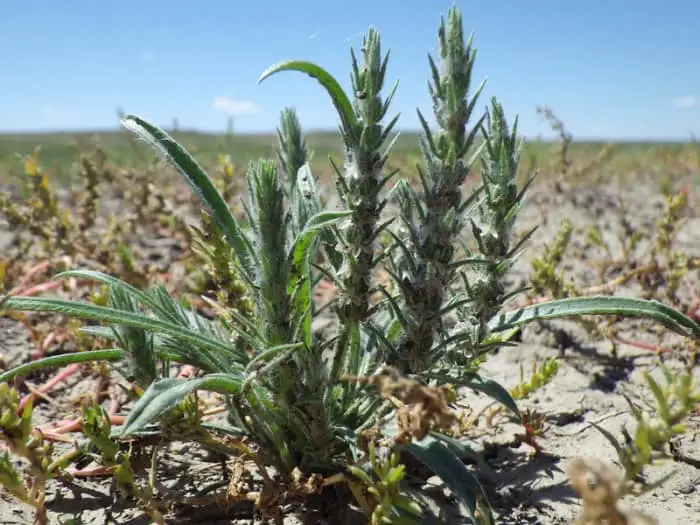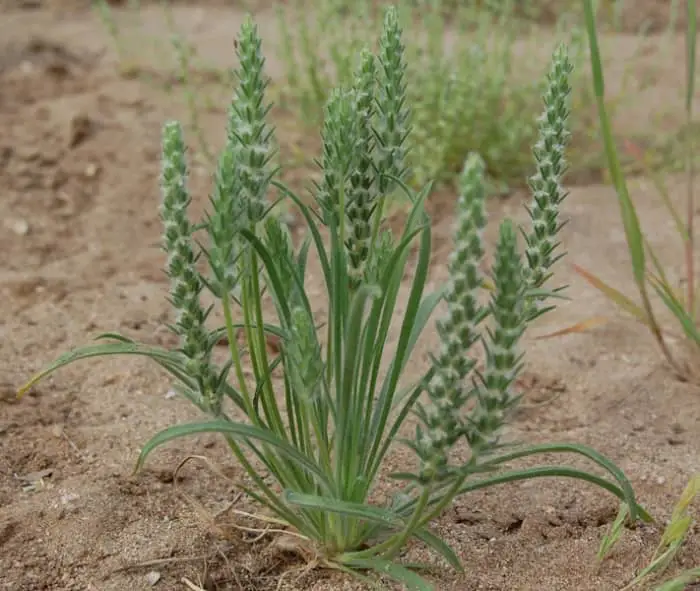Have you got some weeds with velvety leaves in your yard?
We take a look at some of the most common weed types you’re likely to find and help you identify them using photos and descriptions.
Let’s dive in.
Common Mullein (Verbascum thapsus)
Also called great mullein and woolly mullein, common mullein is a giant weed that grows over 7 ft. tall. The common mullein plant has large grey-green leaves that are thick and oval-shaped. A fuzzy covering of woolly hairs gives the mullein leaves a velvety texture. The leaves grow from 4-12 inches long and 1-5 inches wide.
Common mullein is a biennial weed. In the first year, the plant grows a basal rosette of furry leaves. And in the second year, the weed develops a tall stem. Common mullein flowers from June to September. With small yellow flowers clustering in a large spike at the top of the stem.
Originally native to Europe, Asia, and North Africa, great mullein is an invasive weed in many areas of North America and Australia.
For more weeds with hair-covered leaves check out our guide.
Velvetleaf (Abutilon theophrasti)
Growing up to 8 feet, velvetleaf is a tall weed with very large velvety leaves that are heart-shaped, green, and covered in short hairs. Making the leaf soft to the touch and giving rise to its descriptive name (1).
In the summer, the plant produces 5-petalled, orange-yellow flowers that grow up to1-Inch in diameter from the leaf axils on short stalks.
You’ll find velvetleaf growing in gardens and agricultural fields. But it’s also common to find this weed growing beside railroad tracks and roadsides.
In a number of states, velvetleaf is considered a noxious weed. It’s a very competitive plant that takes nutrients and water out of the soil. Preventing crops from getting sufficient quantities and reducing their yield.
And it can be difficult to get rid of. The seeds stay dormant in the soil for a long time. They’re brought to the surface when land is disturbed. And sprout when the soil becomes warm enough in the spring.
Canadian Wild Ginger (Asarum canadense)
Also known as broad-leaved asarabacca and Canadian snakeroot, wild ginger is native to eastern North America, often found growing in deciduous forests. But this weed can also make its way into your garden when the conditions are right.
Wild ginger is a herbaceous perennial weed that likes to grow in the shade, forming a dense groundcover of velvety heart-shaped leaves. The weed spreads through rhizomes and forms clumps that can spread and quickly take over an area.
The plant is low growing, reaching 4-8 inches high. At ground level, beneath the leaves, singular bell-shaped flowers grow. The flowers are hairy and brownish-purple in color.
Wild ginger is not always an unwanted plant, and some people like to use it as a groundcover in shady parts of their garden as it can prevent invasive weeds from becoming established.
Wild ginger also has a history of use as a medicinal herb by Native Americans. But you should avoid consuming any part of this weed as it contains aristolochic acid, a known carcinogen.
Lambsquarters (Chenopodium album)
Also known as white goosefoot, lambsquarters is a common summer annual broadleaf weed often found growing in gardens in the US and Canada.
You can identify this weed by its velvety leaves that have a covering of wooly hairs. The leaves are small, gray-green in color, and triangular-shaped to lance-shaped with wavy edges. The weed grows from several inches to 5 ft. tall with a single central stem that sometimes has side stems.
The plant usually blooms from July to September, with clusters of tiny yellow-green flowers at the end of the stems. Occasionally lambsquarters blooms early in the season.
In the past, lambsquarters was grown for its edible and highly nutritious leaves. But the practice has fallen out of favor due to the viral diseases the weed harbors (2). So it’s best to keep it out of your garden.
Lambsquarters spreads by seed after the plant flowers in late spring or early fall. So try to deal with the weed before then. It’s fairly easy to pull lambsquarters out of the ground as it only has a short taproot.
Jimson Weed (Datura stramonium)
Jimson weed is an invasive weed that’s a member of the nightshade family. It’s also known as thorn apple and devil’s snare.
Jimson weed produces a large fruit encased in a spiky capsule. But be careful not to eat it. Jimson weed is a notorious poisonous weed that’s dangerous when ingested. And just touching the plant can cause a rash.
Jimson weed is a big weed with velvety leaves that grows up to 6.5 ft. tall. The leaves have wavy margins and toothed edges and grow alternately from green stems that are sometimes purple-tinged.
The plant blooms in summer. With trumpet-shaped violet or white flowers up until the first frost.
Houndstongue (Cynoglossum officinale)
Houndstongue is also called sheep bur, dog’s tongue, beggar’s lice, and woolmat. Originally from Asia and Europe, houndstongue is a noxious weed in many US states. The weed can quickly form dense monocultures that sometimes outcompete desirable plants.
Houndstongue is a biennial weed. During the first year of growth, the weed develops soft, velvety leaves in a rosette. The leaves of the weed are big, up to 30cm long, and grow alternately up the stem, becoming smaller nearer to the top.
In the second year, the weed produces a flowering stem that can grow up to 4 feet high. From May to June, houndstongue blooms, producing 5-petalled flowers that vary in color from burgundy to dull red. Clusters of burr-like nutlets develop from each flower and stick to clothing and animal fur, spreading the seed they contain to new locations.
Houndstongue grows well in disturbed areas such as roadsides and overgrazed pastures. And it’s not unusual to find it growing in your backyard or flower beds. The weed is toxic to livestock, and although they usually avoid it, they may eat it if there is a lack of suitable forage.
Lamb’s Ear (Stachys byzantina)
Also known as wooly hedgenettle, lamb’s ear is native to southwestern Asia but is now naturalized in many parts of the world, and is often grown by gardeners as a ground cover. The plant can be a fast and aggressive grower in the right conditions but is not yet officially listed as an invasive weed in the US.
Lamb’s ear is well known as a weed with fuzzy leaves that feel velvety. The plant has a spreading growth, forming an attractive, soft-textured mat of blue-green leaves that have a silvery appearance due to the covering of white wooly hairs.
The leaves are tongue-shaped and can grow up to 6-inches long. In the summer, the weed produces a tall spike of purple flowers that varies in height from 12-18 inches, while the leaves stay close to the ground, spreading out about a foot.
Lamb’s ear is an edible weed that also has medicinal properties. Some people like to eat it in salads where it adds a fruity taste reminiscent of apples and pineapples. You can also use the dry leaves to make tea.
Woolly Plantain (Plantago patagonica)
PLANTAGO PATAGONICA BY MATT LAVIN
Also called pursh plantain, woolly Indian wheat, and Patagonian plantain, woolly plantain can be either an annual or a perennial broadleaf weed. The weed is native to North America and is also found in parts of South America. Not everyone considers woolly plantain a weed, the plant has a history of use by some Native Americans as a medicinal plant.
The weed has velvety leaves that are thin and linear. The leaves are basal, stalkless, and covered in white hairs giving the weed a woolly appearance. Leafless, hairy stalks stand erect from the basal leaves, with a compact, thin spike of tiny greenish-white flowers at the ends.
WOOLLY PLANTAIN BY MIKE, CC BY-SA 3.0, VIA WIKIMEDIA COMMONS
The individual seed pods contain 2 reddish-brown seeds. And when they split they deposit the seeds onto the ground.
Once in the soil, the seeds remain viable for many years. So if you allow woolly plantain weeds to grow unchecked, you can expect them to keep appearing year after year, even if you eventually remove the plants.
Read More:
Reference:
- Velvetleaf – https://hort.extension.wisc.edu/articles/velvetleaf-abutilon-theophrasti/
- Common Lambsquarters – https://wiki.bugwood.org/HPIPM:Common_lambsquarters
- Houndstongue Is A Controllable Problem On Range And Wild Lands – https://www.montana.edu/news/7237/houndstongue-is-a-controllable-problem-on-range-and-wild-lands
